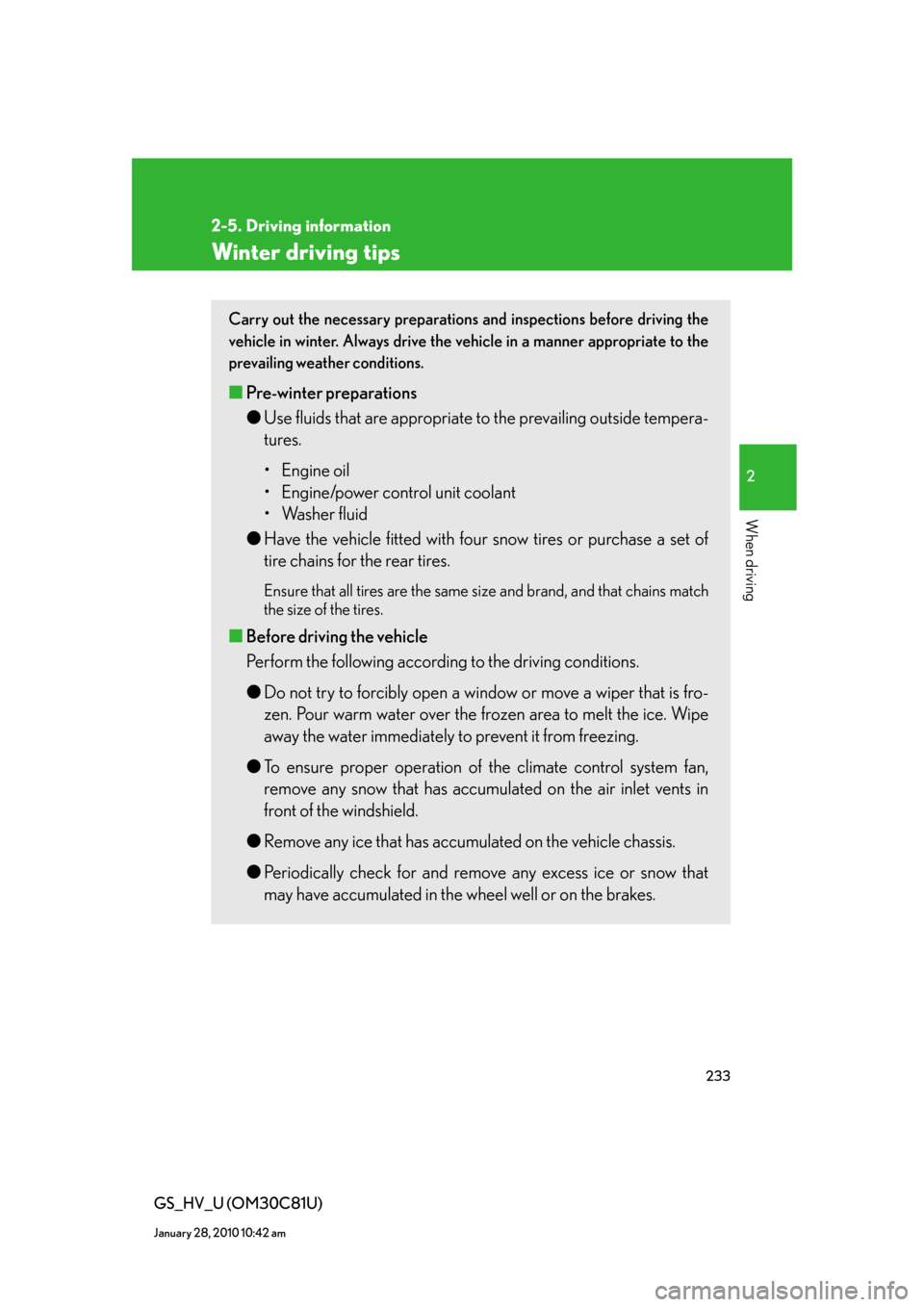tires Lexus GS450h 2010 Using The Audio System / LEXUS 2010 GS450H OWNERS MANUAL (OM30C81U)
[x] Cancel search | Manufacturer: LEXUS, Model Year: 2010, Model line: GS450h, Model: Lexus GS450h 2010Pages: 644, PDF Size: 15.8 MB
Page 5 of 644

1
2
3
4
5
6
7
5
GS_HV_U (OM30C81U)
February 1, 2010 10:54 am
4-1. Maintenance and care
Cleaning and protecting
the vehicle exterior................... 442
Cleaning and protecting
the vehicle interior .................... 445
4-2. Maintenance
Maintenance requirements ..... 448
General maintenance ............... 450
Emission inspection and
maintenance (I/M)
programs ...................................... 4534-3. Do-it-yourself maintenance
Do-it-yourself service
precautions .................................. 454
Hood ................................................. 457
Positioning a floor jack.............. 458
Engine compartment.................. 460
Tires ................................................... 475
Tire inflation pressure................ 485
Wheels ............................................ 489
Air conditioning filter................... 491
Electronic key battery ................ 494
Checking and replacing
fuses ................................................ 496
Headlight aim ................................... 511
Light bulbs ........................................ 514
5-1. Essential information
Emergency flashers .................... 522
If your vehicle needs to be
towed ............................................. 523
If you think something is
wrong .............................................. 531
Event data recorder.................... 532
4Maintenance and care
5When trouble arises
Page 6 of 644

TABLE OF CONTENTSIndex
6
GS_HV_U (OM30C81U)
February 1, 2010 10:54 am
5-2. Steps to take in an emergency
If a warning light turns
on or a warning buzzer
sounds... ......................................... 534
If a warning message is
displayed ....................................... 543
If you have a flat tire (Vehicles
with standard tires) .................. 560
If you have a flat tire (Vehicles
with run-flat tires) ...................... 570
If the hybrid system will not
start ................................................. 572
If the shift lever cannot be shifted
from “P” ......................................... 573
If you lose your keys .................... 574
If the electronic key does not
operate properly ....................... 575
If the 12 volt battery is
discharged ................................... 578
If your vehicle overheats ............ 581
If the vehicle becomes
stuck............................................... 584
If your vehicle has to be stopped
in an emergency ....................... 5866-1. Specifications
Maintenance data
(fuel, oil level, etc.).................... 588
Fuel information ........................... 598
Tire information.............................. 601
6-2. Customization
Customizable features................ 615
6-3. Initialization
Items to initialize ............................ 621
Reporting safety defects
for U.S. owners........................... 624
Seat belt instructions
for Canadian owners
(in French) .................................... 625
Abbreviation list........................ 628
Alphabetical index ................... 630
What to do if... ............................ 640
6Vehicle specifications
7For owners
Index
Page 141 of 644

141
2-1. Driving procedures
2
When driving
GS_HV_U (OM30C81U)
October 13, 2015 12:41 pm
■Driving in the rain
●Drive carefully when it is raining, because visibility will be reduced, the windows
may become fogged-up, and the road will be slippery.
●Drive carefully when it starts to rain, because the road surface will be especially
slippery.
●Refrain from high speeds when driving on an expressway in the rain, because
there may be a layer of water between the tires and the road surface, preventing
the steering and brakes from operating properly.
■Breaking in your new Lexus
To extend the life of the vehicle, the following precautions are recommended to
observe:
●For the first 186 miles (300 km):
Avoid sudden stops.
●For the first 621 miles (1000 km):
• Do not drive at extremely high speeds.
• Avoid sudden acceleration.
• Do not drive continuously in the low range in the “S” position.
• Do not drive at a constant speed for extended periods.
■Drum-in-disc type parking brake system
Your vehicle has a drum-in-disc type parking brake system.
This type of brake system needs bedding-down of the brake shoes periodically or
whenever the parking brake shoes and/or drums are replaced.
Have your Lexus dealer perform the bedding-down.
■Operating your vehicle in a foreign country
Comply with the relevant vehicle registration laws and confirm the availability of the
correct fuel. (P. 5 9 0 )
■When starting on an incline
The hill-start assist control may operate. (P. 2 1 4 )
Page 144 of 644

144
2-1. Driving procedures
GS_HV_U (OM30C81U)
October 13, 2015 12:41 pm
CAUTION
■When driving the vehicle
●Moving the shift lever to "N" while the vehicle is moving will disengage the hybrid
system. Engine braking is not available with the hybrid system disengaged.
●During normal driving, do not turn off the hybrid system. Turning the hybrid sys-
tem off while driving will not cause loss of steering or braking control, but the
power assist to these systems will be lost. This will make it more difficult to steer
and brake, so you should pull over and stop the vehicle as soon as it is safe to do
so.
However, in the event of an emergency, such as if it becomes impossible to stop
the vehicle in the normal way: P. 5 3 4
●Use engine braking (downshift) to maintain a safe speed when driving down a
steep hill.
Using the brakes continuously may cause the brakes to overheat and lose effec-
tiveness. (P. 1 5 6 )
●When stopped on an inclined surface, use the brake pedal and parking brake to
prevent the vehicle from rolling backward or forward and causing an accident.
●Be careful when driving on slippery surfaces, as the vehicle may spin or skid when
downshifting, rapidly accelerating, braking or turning.
●Do not adjust the position of the steering wheel, the seat, or the inside or outside
rear view mirrors while driving.
Doing so may result in a loss of vehicle control that can cause accidents that may
result in death or serious injury.
●Always check that all passengers’ arms, heads or other parts of their bodies are
not outside the vehicle, as this may result in death or serious injury.
●Do not drive in excess of the speed limit. Even if the legal speed limit permits it, do
not drive over 85 mph (140 km/h) unless your vehicle has high-speed capability
tires. Driving over 85 mph (140 km/h) may result in tire failure, loss of control and
possible injury. Be sure to consult a tire dealer to determine whether the tires on
your vehicle are high-speed capability tires or not before driving at such speeds.
●The driver should pay attention to pedestrians when the vehicle is powered only
by the electric motor (traction motor). Because there is no engine sounds, the
pedestrians may misjudge the vehicle’s movement.
Page 147 of 644

147
2-1. Driving procedures
2
When driving
GS_HV_U (OM30C81U)
October 13, 2015 12:41 pm
CAUTION
■When taking a nap in the vehicle
Always turn the hybrid system off. Otherwise, you may accidentally move the shift
lever or depress the accelerator pedal, which could cause an accident or fire due to
hybrid system overheating. Additionally, if the vehicle is parked in a poorly venti-
lated area, exhaust gases may collect and enter the vehicle, leading to death or a
serious health hazard.
■When braking the vehicle
●When the brakes are wet, drive more cautiously.
Braking distance increases when the brakes are wet, and may cause one side of
the vehicle to brake differently than the other side. Also the parking brake may
not securely hold the vehicle.
●If the brake actuator does not operate, do not follow other vehicles closely and
avoid downhill or sharp turns that require making.
In this case, braking is still possible, but it will require more force on the pedal than
usual. Braking distance may also increase.
●The brake system consists of 3 individual hydraulic systems: If one of the systems
fails, the other will still operate. In this case, the brake pedal should be depressed
more firmly than usual and braking distance becomes longer.
Do not drive your vehicle with only a single brake system. Have your brakes fixed
immediately.
■If the vehicle becomes stuck or bogged
Do not spin the wheels recklessly when any of the tires is up in the air, or stuck in
sand or mud, etc. This may damage the drive system components or propel the
vehicle forward (or in another direction) and cause an accident.
Page 209 of 644

209
2-4. Using other driving systems
2
When driving
GS_HV_U (OM30C81U)
October 13, 2015 12:41 pm
NOTICE
■When using the intuitive parking assist
In the following situations, the system may not function correctly due to a sensor
malfunction etc. Have the vehicle checked by your Lexus dealer.
●A beep does not sound when you turn the main switch on.
●The intuitive parking assist operation display flashes, and a beep sound when no
obstacle has been detected.
●If the area around a sensor collides with something, or is subjected to strong
impact.
●If the bumper collides with something.
●If the display shows continuously without a beep.
■When changing tires
If you install tires of a size other than that recommended by the manufacturer, the
system will be unable to correctly detect steering wheel movement. Always use tire
sizes recommended by the manufacturer.
■When washing the vehicle
When washing the vehicle using high pressure cleaning equipment, do not spray
water directly on the sensors. Subjecting the sensors to high pressure impact may
cause a malfunction.
Page 220 of 644

220
2-4. Using other driving systems
GS_HV_U (OM30C81U)
October 13, 2015 12:41 pm
CAUTION
■If the hill-start assist control does not operate effectively
Do not overly rely on the hill-start assist control. The hill-start assist control may not
operate effectively on steep inclines and roads covered in ice.
■When the Enhanced VSC is activated
The slip indicator light flashes and a warning buzzer sounds. Always drive carefully.
Reckless driving may cause an accident. Exercise particular care when the indica-
tor light flashes and a buzzer sounds.
■When TRAC and Enhanced VSC are off
Be especially careful and drive at a speed appropriate to the road conditions. As
these are systems to ensure vehicle stability and driving force, do not turn off TRAC
and Enhanced VSC unless necessary.
■Replacing tires
Make sure that all tires are of the same size, brand, tread pattern and total load
capacity. In addition, make sure that the tires are inflated to the specified tire pres-
sure level.
The ABS and Enhanced VSC will not function correctly if different tires are fitted on
the vehicle.
Contact your Lexus dealer for further information when replacing tires or wheels.
■Handling of tires and suspension
Using tires with any kind of problem or modifying the suspension will affect the driv-
ing assist systems, and may cause the system to malfunction.
Page 232 of 644

232
2-5. Driving information
GS_HV_U (OM30C81U)
January 28, 2010 10:42 am
Vehicle load limits
■Total load capacity and seating capacity
These details are also described on the tire and loading information label.
(P. 485)
CAUTION
■Overloading the vehicle
Do not overload the vehicle.
It may not only cause damage to the tires, but also degrade steering and braking
ability, resulting in an accident.
Vehicle load limits include total load capacity, seating capacity, towing
capacity and cargo capacity.
■Total load capacity: 815 lb. (370 kg)
Total load capacity means the combined weight of occupants, cargo
and luggage.
■Seating capacity: 5 occupants (Front 2, Rear 3)
Seating capacity means the maximum number of occupants whose
estimated average weight is 150 lb. (68 kg) per person.
Even if the number of occupants are within the seating capacity, do
not exceed the total load capacity.
■Towing capacity
Lexus does not recommend towing a trailer with your vehicle.
■Cargo capacity
Cargo capacity may increase or decrease depending on the weight
and the number of occupants.
Page 233 of 644

233
2-5. Driving information
2
When driving
GS_HV_U (OM30C81U)
January 28, 2010 10:42 am
Winter driving tips
Carry out the necessary preparations and inspections before driving the
vehicle in winter. Always drive the vehicle in a manner appropriate to the
prevailing weather conditions.
■Pre-winter preparations
●Use fluids that are appropriate to the prevailing outside tempera-
tures.
• Engine oil
• Engine/power control unit coolant
• Washer fluid
●Have the vehicle fitted with four snow tires or purchase a set of
tire chains for the rear tires.
Ensure that all tires are the same size and brand, and that chains match
the size of the tires.
■Before driving the vehicle
Perform the following according to the driving conditions.
●Do not try to forcibly open a window or move a wiper that is fro-
zen. Pour warm water over the frozen area to melt the ice. Wipe
away the water immediately to prevent it from freezing.
●To ensure proper operation of the climate control system fan,
remove any snow that has accumulated on the air inlet vents in
front of the windshield.
●Remove any ice that has accumulated on the vehicle chassis.
●Periodically check for and remove any excess ice or snow that
may have accumulated in the wheel well or on the brakes.
Page 234 of 644

234
2-5. Driving information
GS_HV_U (OM30C81U)
January 28, 2010 10:42 am
Regulations on the use of tire chains
●Regulations regarding the use of tire chains vary according to location
and type of road. Always check local regulations before installing
chains.
●Use SAE Class “S” type radial tire chains, with the exception of radial
cable chains or V-bar type chains.
• Install the chains on the rear tires.
• Refer to the explanation that comes with the tire chains for installa-
tion instructions.
●Retighten the chains after driving 1 /4 - 1 /2 mile (0.5 - 1.0 km).
■When driving the vehicle
Accelerate the vehicle slowly and drive at a reduced speed suitable
to road conditions.
■When parking the vehicle
Park the vehicle and move the shift lever to “P” without setting the
parking brake. The parking brake may freeze up, preventing it from
being released. If necessary, block the wheels to prevent inadvert-
ent sliding or creeping.